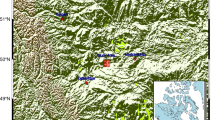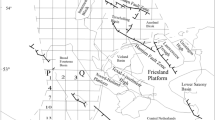Abstract
The ratio of compressional wave velocity to shear wave velocity (VP/VS ratio) has established itself as one of the most important parameters in identifying gas reservoirs. However, considering that seismic inversion process is highly non-linear and geological conditions encountered may be complex, a direct estimation of VP/VS ratio from pre-stack seismic data remains a challenging task. In this paper, we propose a hybrid seismic inversion method to estimate VP/VS ratio directly. In this method, post- and pre-stack inversions are combined in which the pre-stack inversion for VP/VS ratio is driven by the post-stack inversion results (i.e., VP and density). In particular, the VP/VS ratio is considered as a model parameter and is directly inverted from the pre-stack inversion based on the exact Zoeppritz equation. Moreover, anisotropic Markov random field is employed in order to regularise the inversion process as well as taking care of geological structures (boundaries) information. Aided by the proposed hybrid inversion strategy, the directional weighting coefficients incorporated in the anisotropic Markov random field neighbourhoods are quantitatively calculated by the anisotropic diffusion method. The synthetic test demonstrates the effectiveness of the proposed inversion method. In particular, given low quality of the pre-stack data and high heterogeneity of the target layers in the field data, the proposed inversion method reveals the detailed model of VP/VS ratio that can successfully identify the gas-bearing zones.

















Similar content being viewed by others
References
Aki, K., & Richards, P. G. (1980). Quantitative seismology: Theory and methods. San Francisco: W. H. Freeman.
Aleardi, M., & Tognarelli, A. (2016). The limits of narrow and wide-angle AVA inversions for high V p/Vs ratios: An application to elastic seabed characterization. Journal of Applied Geophysics, 131, 54–68.
Anderson, P. F., & Lines, L. R. (2008). A comparison of inversion techniques for estimating V p/V s from 3D seismic data. CREWES Research Report, 20, 1–21.
Benabentos, M., Mallick, S., Sigismondi, M., & Soldo, J. (2002). Seismic reservoir description using hybrid seismic inversion: A 3D case study from the María Inés Oeste Field, Argentina. The Leading Edge, 21(10), 1002–1008.
Bhatt, J. S., Joshi, M. V., & Raval, M. S. (2014). A data-driven stochastic approach for unmixing hyperspectral imagery. IEEE Journal of Selected Topics in Applied Earth Observations and Remote Sensing, 7(6), 1936–1946.
Black, M. J., Sapiro, G., Marimont, D. H., & Heeger, D. (1998). Robust anisotropic diffusion. IEEE Transactions on Image Processing, 7(3), 421–432.
Buland, A., & Omre, H. (2003). Bayesian linearized AVO inversion. Geophysics, 68(1), 185–198.
Charbonnier, P., Blanc-Féraud, L., Aubert, G., & Barlaud, M. (1997). Deterministic edge-preserving regularization in computed imaging. IEEE Transactions on Image Processing, 6(2), 298–311.
Compton, S., & Hale, D. (2014). Estimating V p/V s ratios using smooth dynamic image warping. Geophysics, 79(6), V201–V215.
Dumitrescu, C. C., & Lines, L. (2007). Heavy oil reservoir characterization using V p/V s ratios from multicomponent data. In Proceedings 69th EAGE conference and exhibition incorporating SPE EUROPEC, June 2007, London, UK, Extended Abstract.
Dumitrescu, C. C., & Lines, L. (2010). Integrated characterization of heavy oil reservoir using V p/V s ratio and neural network analysis. Journal of Seismic Exploration, 19(3), 231–248.
Fatti, J. L., Smith, G. C., Vail, P. J., Strauss, P. J., & Levitt, P. R. (1994). Detection of gas in sandstone reservoirs using AVO analysis: A 3-D seismic case history using the Geostack technique. Geophysics, 59(9), 1362–1376.
Geman, S., & Geman, D. (1984). Stochastic relaxation, Gibbs distributions, and the Bayesian restoration of images. IEEE Transactions on Pattern Analysis and Machine Intelligence, 6(6), 721–741.
Geman, S., & Reynolds, G. (1992). Constrained restoration and the recovery of discontinuities. IEEE Transactions on Pattern Analysis and Machine Intelligence, 14(3), 367–383.
Guliyev, E., & Davis, T. L. (2007). Interpretation of V p/V s velocity ratio for improved tight gas sandstone reservoir characterization, Rulison field, Colorado. In Proceedings SEG international exposition and 77th annual meeting, Sept. 2007, San Antonio, Texas, Expanded Abstract (pp. 1451–1455).
Guo, Q., Islam, N., & Pennington, W. D. (2015). Tuning of flat spots with overlying bright spots, dim spots, and polarity reversals. Interpretation, 3(3), SS37–SS48.
Haber, E., & Gazit, M. H. (2013). Model fusion and joint inversion. Surveys In Geophysics, 34(5), 675–695.
Hamada, G. M. (2004). Reservoir fluids identification using V p/V s ratio. Oil & Gas Science and Technology, 59(6), 649–654.
Hilterman, F. J. (2001). Seismic amplitude interpretation: Distinguished instructor short course. Houston: SEG/EAGE.
Kennedy, J., & Eberhart, R. (2002). Particle swarm optimization. In Proceedings IEEE international conference on neural networks, Aug. 2002, Perth, Australia (pp. 1942–1948).
Liang, L., Zhang, H., Guo, Q., Saeed, W., & Shang, Z. (2017). Stability study of pre-stack seismic inversion based on the full Zoeppritz equation. Journal of Geophysics and Engineering, 14(5), 1242–1259.
Lines, L., Zou, Y., Zhang, A., Hall, K., Embleton, J., Palmiere, B., et al. (2005). V p/V s characterization of a heavy-oil reservoir. The Leading Edge, 24(11), 1134–1136.
Malinverno, A. (2002). Parsimonious Bayesian Markov chain Monte Carlo inversion in a nonlinear geophysical problem. Geophysical Journal International, 151(3), 675–688.
Mallick, S., Huang, X., Lauve, J., & Ahmad, R. (2000). Hybrid seismic inversion: A reconnaissance tool for deepwater exploration. The Leading Edge, 19(11), 1230–1237.
Ojha, M., & Sain, K. (2008). Appraisal of gas-hydrate/free-gas from V p/V s ratio in the Makran accretionary prism. Marine and Petroleum Geology, 25(7), 637–644.
Ostrander, W. J. (1984). Plane-wave reflection coefficients for gas sands at nonnormal angles of incidence. Geophysics, 49(10), 1637–1648.
Pasquet, S., Bodet, L., Longuevergne, L., Dhemaied, A., Camerlynck, C., & Rejiba, F. (2015). 2D characterization of near-surface V p/V s: Surface-wave dispersion inversion versus refraction tomography. Near Surface Geophysics, 13(4), 315–331.
Rimstad, K., & Omre, H. (2010). Impact of rock-physics depth trends and Markov random fields on hierarchical Bayesian lithology/fluid prediction. Geophysics, 75(4), R93–R108.
Shaw, R., & Srivastava, S. (2007). Particle swarm optimization: A new tool to invert geophysical data. Geophysics, 72(2), F75–F83.
Stewart, R. R., Gaiser, J. E., Brown, R. J., & Lawton, D. C. (2003). Converted-wave seismic exploration: Applications. Geophysics, 68(1), 40–57.
Tarantola, A. (2005). Inverse problem theory and model parameter estimation. Philadelphia: SIAM.
Wang, X., Schubnel, A., Fortin, J., David, E. C., Gueguen, Y., & Ge, H. (2012). High V p/V s ratio: Saturated cracks or anisotropy effects. Geophysical Research Letters, 39(11), L11307.
Wilkens, R., Simmons, G., & Caruso, L. (1984). The ratio V p/V s as a discriminant of composition for siliceous limestones. Geophysics, 49(11), 1850–1860.
Xi, X., Yun, L., Zhang, X., Kang, H., Chen, J., Wang, D., & Guo, X. (2016). Reservoir characterization using post-stack inversion and pre-stack simultaneous inversion: A case study in oil field development. In Proceedings SEG international exposition and 86th annual meeting, Aug. 2016, Dallas, Texas, Expanded Abstract (pp. 3799–3803).
Yin, X., & Zhang, S. (2014). Bayesian inversion for effective pore-fluid bulk modulus based on fluid-matrix decoupled amplitude variation with offset approximation. Geophysics, 79(5), R221–R232.
Zhang, H., Guo, Q., Liang, L., Cao, C., & Shang, Z. (2018). A nonlinear method for multiparameter inversion of pre-stack seismic data based on anisotropic Markov random field. Geophysical Prospecting, 66(3), 461–477.
Zhang, H., Shang, Z., & Yang, C. (2007). A non-linear regularized constrained impedance inversion. Geophysical Prospecting, 55(6), 819–833.
Zimmer, M., Prasad, M., & Mavko, G. (2002). Pressure and porosity influences on V p–V s ratio in unconsolidated sands. The Leading Edge, 21(2), 835–839.
Zong, Z., & Yin, X. (2017). Model parameterization and P-wave AVA direct inversion for Young’s impedance. Pure and Applied Geophysics, 174(5), 1965–1981.
Zong, Z., Yin, X., & Wu, G. (2013). Multi-parameter nonlinear inversion with exact reflection coefficient equation. Journal of Applied Geophysics, 98(11), 21–32.
Acknowledgements
The authors gratefully appreciate the two anonymous reviewers for offering valuable comments that led to great improvements in the paper. The authors acknowledge the considerable support provided by the National Natural Science Foundation of China (41374116 and 41674113) and the Fundamental Research Funds for the Central Universities (KYLX16_0758). The authors also acknowledge CNOOC Limited for providing the field data for analysis.
Author information
Authors and Affiliations
Corresponding author
Rights and permissions
About this article
Cite this article
Guo, Q., Zhang, H., Han, F. et al. A Hybrid Seismic Inversion Method for VP/VS Ratio and Its Application to Gas Identification. Pure Appl. Geophys. 175, 3003–3022 (2018). https://doi.org/10.1007/s00024-018-1829-6
Received:
Revised:
Accepted:
Published:
Issue Date:
DOI: https://doi.org/10.1007/s00024-018-1829-6




